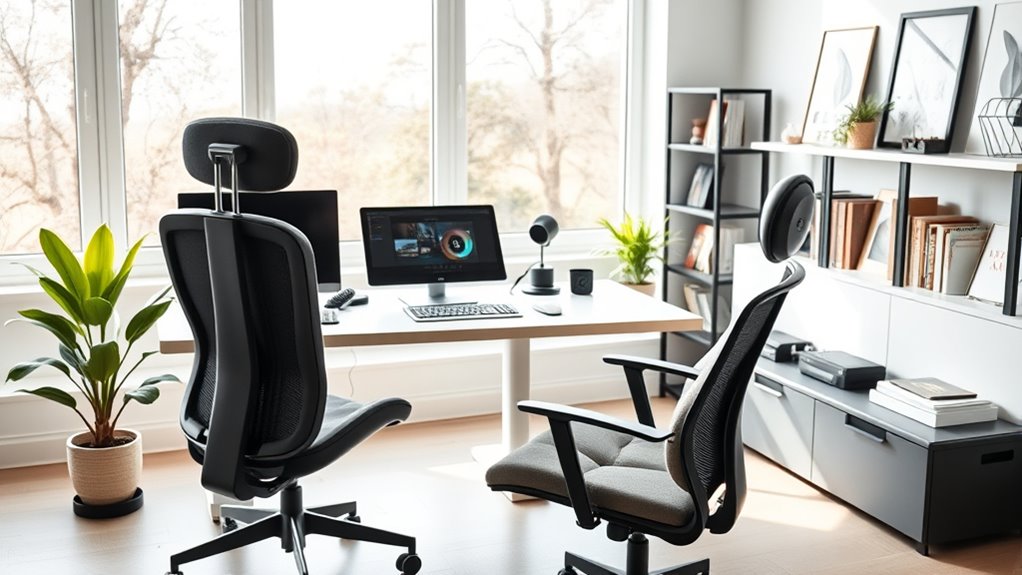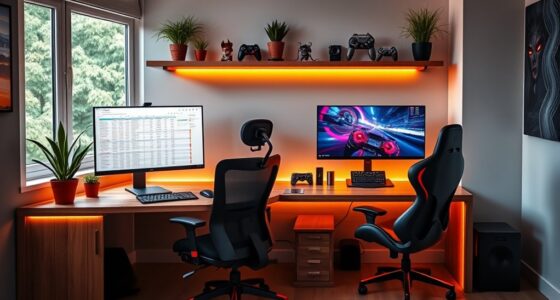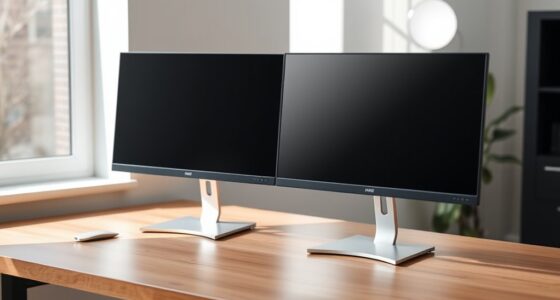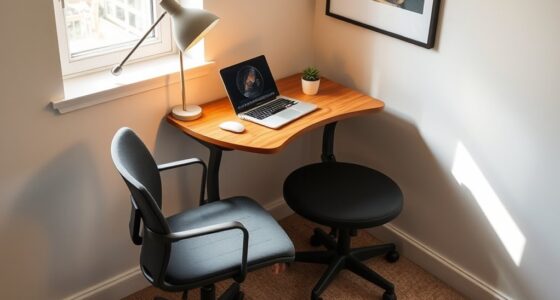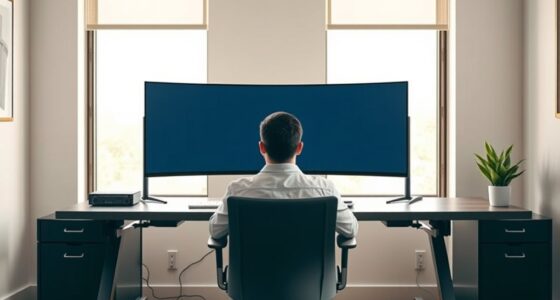To optimize your home workspace, adjust your chair so your feet are flat and your elbows form a 90° angle. Position your monitor at eye level and about an arm’s length away to prevent neck and eye strain. Use ergonomic tools like supportive cushions, adjustable stands, and proper lighting to boost comfort. Remember to take regular breaks for stretching and movement. Keep exploring these tips to create a healthier, more productive art environment.
Key Takeaways
- Adjust your workspace height so your elbows are at 90° and feet are flat on the floor or footrest.
- Position monitors at eye level, about an arm’s length away, to reduce neck and eye strain.
- Use adjustable ergonomic tools like wrist supports and chairs to customize comfort and reduce repetitive strain.
- Schedule hourly breaks to stand, stretch, and move, promoting circulation and preventing stiffness.
- Keep your workspace organized and well-lit with natural or adjustable lighting to minimize eye fatigue and boost focus.
Assessing and Adjusting Your Desk and Chair Setup
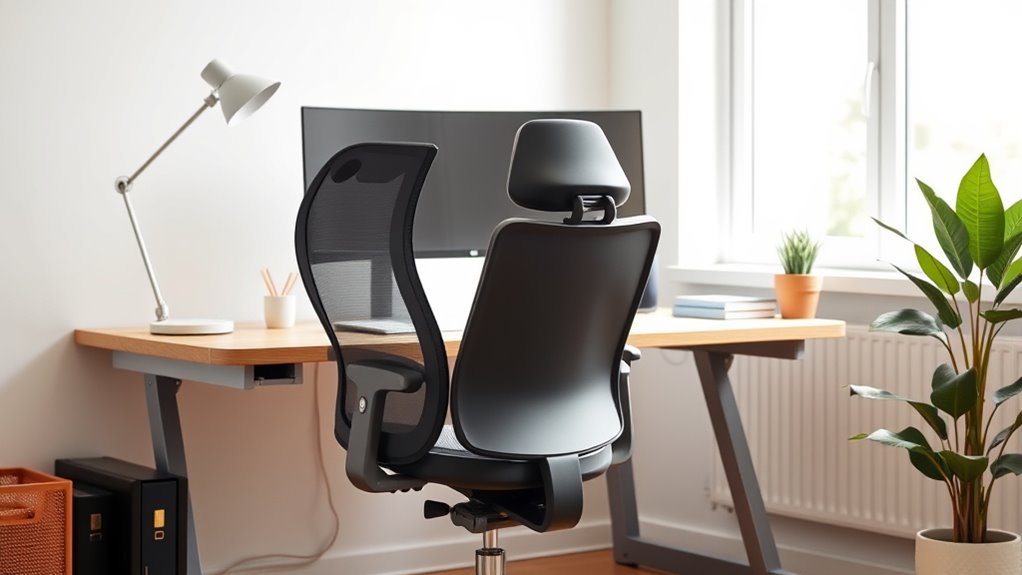
To work comfortably and prevent strain, it’s essential to evaluate and fine-tune your desk and chair setup regularly. Start by adjusting your desk height so your elbows stay at a 90-degree angle when typing or drawing, reducing shoulder tension. Your chair should support your lower back with proper lumbar support; adjust the chair’s lumbar feature to fit the natural curve of your spine. Make sure your feet are flat on the floor or on a footrest, and your knees are level with or slightly below your hips. Regularly check your posture, ensuring your back remains supported and your wrists aren’t strained. Small adjustments can make a significant difference in preventing discomfort and promoting long-term ergonomic health. Additionally, being aware of AI safety measures can help you stay informed about technological risks that could impact your work environment.
Proper Monitor Placement for Reduced Strain
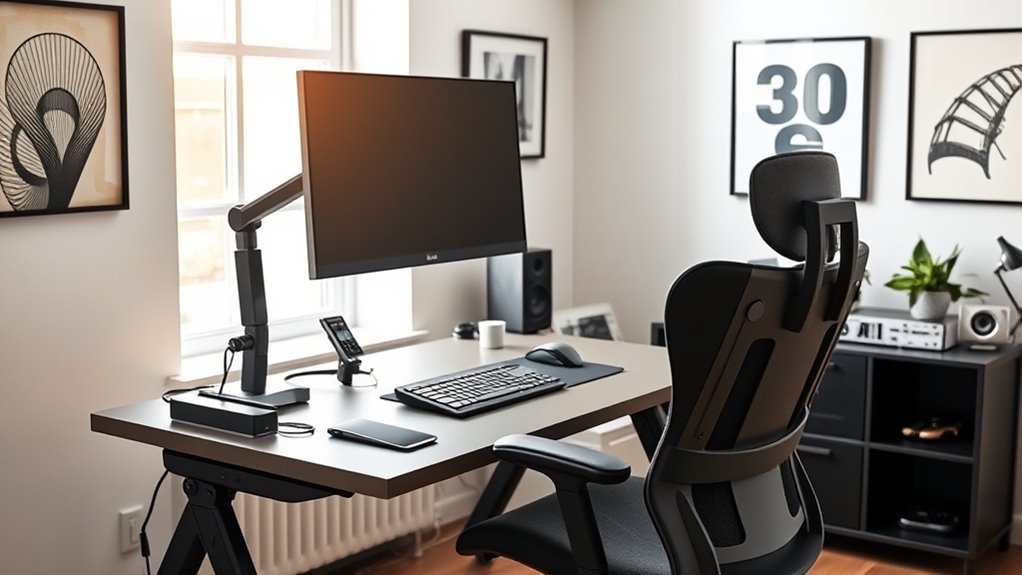
Ensuring your monitor is correctly positioned is key to reducing eye and neck strain during long work sessions. First, set your monitor height so that the top of the screen is at or just below eye level, keeping your neck in a natural position. Second, maintain a comfortable screen distance—about an arm’s length away—to prevent eye fatigue. Third, tilt the monitor slightly upward for easier viewing without tilting your head. Fourth, ensure your monitor is directly in front of you, avoiding any sideways angles that cause twisting. Adjusting these factors helps you work more comfortably and reduces strain. Remember, small changes make a big difference in creating an ergonomic workspace that supports your health during extended creative sessions.
Ergonomic Tools and Accessories to Enhance Comfort

Using the right ergonomic tools and accessories can considerably boost your comfort and productivity when working from home. Invest in ergonomic tools like adjustable keyboard stands, wrist supports, and ergonomic mice to reduce strain and improve posture. Comfort accessories such as cushioned footrests, seat cushions, and lumbar supports help maintain proper alignment and prevent discomfort during long work sessions. These tools promote better movement and stability, reducing fatigue and the risk of injury. Choose adjustable and supportive options to tailor your setup to your specific needs. Incorporating ergonomic tools and comfort accessories into your workspace creates a healthier environment, allowing you to focus on your creative work with less physical stress and greater ease. Additionally, selecting performance-oriented equipment can further enhance your comfort and efficiency during extended work periods.
Optimal Lighting and Environment for Creativity and Well-being
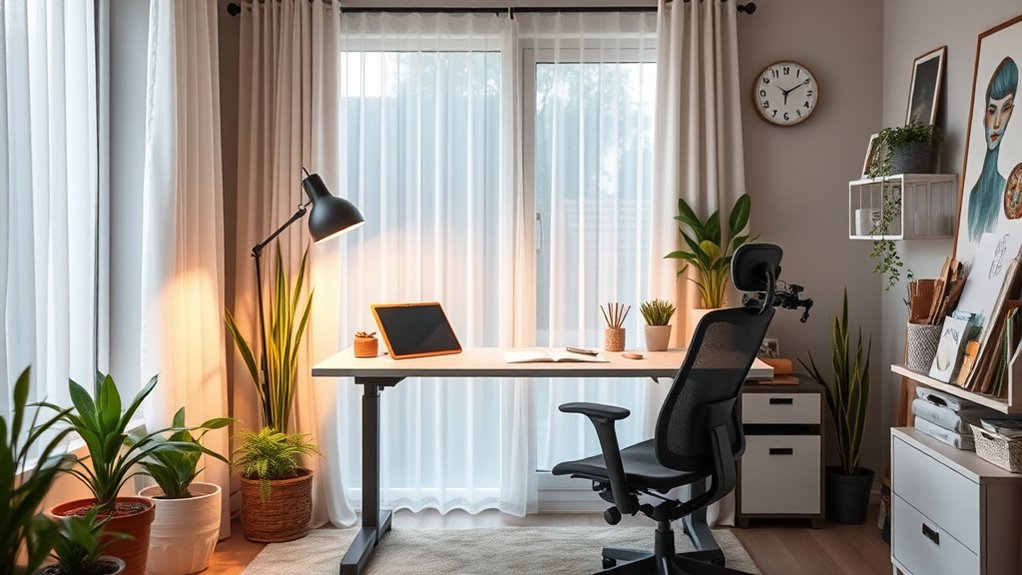
Creating the right lighting and environment is essential for boosting your creativity and maintaining well-being while working from home. Proper lighting, especially with the right color temperature, reduces eye strain and enhances mood. Adjust your workspace’s ambient noise levels to stay focused; some prefer silence, while others benefit from soft background sounds. Consider these tips:
- Use natural light whenever possible, ideally with a daylight-balanced color temperature.
- Incorporate adjustable lighting to shift from warm to cool tones as needed.
- Minimize ambient noise with noise-canceling headphones or soft background music.
- Keep your environment clean and clutter-free to promote a calm, inspiring workspace.
- Regularly check and optimize your workspace for ergonomic setup to prevent discomfort and support sustained focus.
This setup not only fosters creativity but also improves overall comfort and focus.
Incorporating Movement and Stretch Breaks Into Your Routine
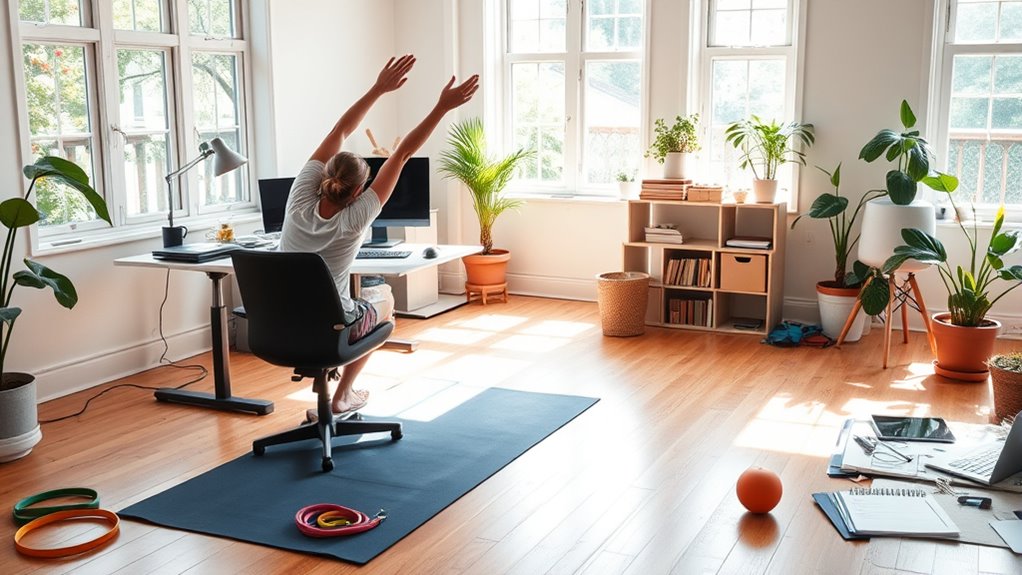
To keep your body energized and avoid stiffness, schedule regular movement and stretch breaks throughout your workday. Incorporate simple stretching exercises that target common tension points, like your neck, shoulders, and back. Use reminders or alarms to prompt you, ensuring you don’t forget to take these quick, beneficial breaks. Paying attention to your posture during work can also help prevent discomfort and improve overall ergonomics.
Schedule Regular Movement Breaks
Even if your work sessions are focused and immersive, taking regular movement breaks is essential for maintaining your energy and preventing strain. To support good desk ergonomics and optimize workspace organization, schedule breaks every hour. During these pauses, try:
- Standing up and walking around to increase circulation
- Doing simple stretches to loosen tight muscles
- Adjusting your workspace setup for better ergonomics
- Moving your monitor or tools to encourage ergonomic posture shifts
Additionally, consider checking the retail hours today for nearby stores if you need supplies or equipment to enhance your workspace comfort.
Incorporate Stretching Exercises
Incorporating stretching exercises into your routine can substantially reduce muscle tension and improve your overall comfort during long work sessions. Focus on maintaining good desk posture, ensuring your back is supported and your monitor is at eye level. During breaks, do wrist stretches to prevent strain from prolonged desk work. Extend your arms, gently bend your wrists, and rotate them to loosen tight muscles. Incorporate simple neck and shoulder stretches to ease tension in those areas. These movements don’t have to be lengthy; even a minute or two can make a difference. Regularly stretching helps prevent stiffness, boosts circulation, and keeps you more comfortable throughout your creative day. Making stretching a consistent habit will markedly enhance your ergonomic setup. Additionally, understanding AI-related job roles can help you adapt your workspace for future technological changes.
Use Reminders and Alarms
Setting reminders and alarms is an effective way to make certain you take regular movement and stretch breaks during your workday. Digital reminders and alarm alerts help keep you accountable and prevent prolonged sitting. To make this easier, try these strategies:
- Set alarms every 30-60 minutes to prompt a quick stretch or walk around.
- Use your phone or computer to create recurring reminders for movement breaks.
- Label alarms with specific activities, like “stand up” or “stretch now.”
- Combine alarms with visual cues, such as changing your background or notification sound, to catch your attention.
- Incorporate precious metals investments into your financial planning to diversify your assets and protect against inflation.
Tips for Maintaining Good Posture Throughout the Day
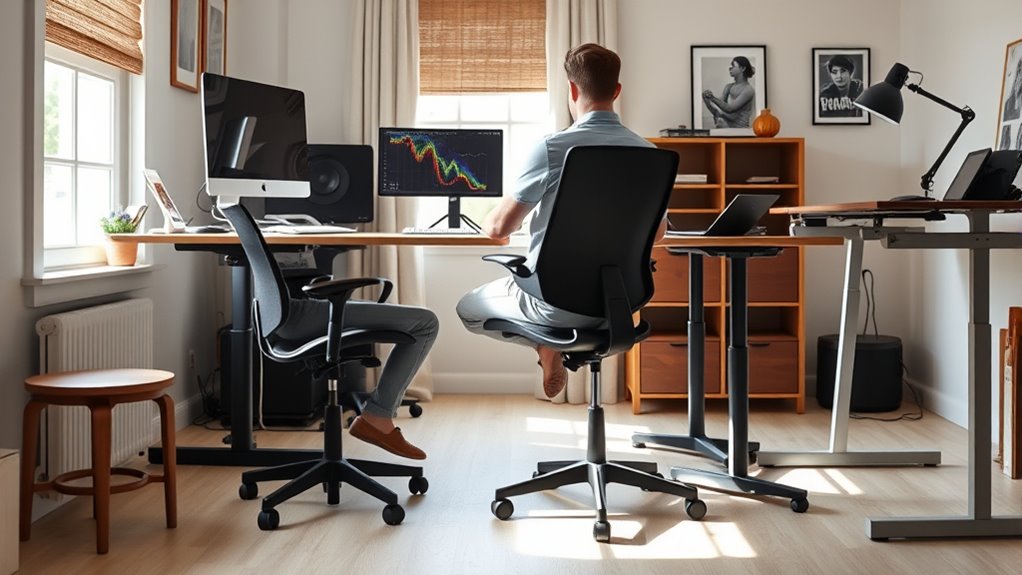
Maintaining good posture throughout the day is crucial for preventing discomfort and long-term injuries, especially when working from home. To achieve posture improvement, incorporate ergonomic hacks into your routine. Sit with your feet flat on the ground and your knees at a 90-degree angle. Keep your monitor at eye level to avoid straining your neck. Use a supportive chair that encourages proper spinal alignment. Take regular breaks to stretch and change positions, preventing stiffness. Adjust your workspace to ensure your wrists are straight while typing. Stay mindful of your posture by setting reminders or alarms. Incorporating ergonomic principles into your workspace design can further enhance comfort and support proper posture. Consistent attention to ergonomic hacks fosters better posture, reduces fatigue, and helps you stay comfortable during long creative sessions. Proper posture is essential for your health and productivity.
Frequently Asked Questions
How Can I Prevent Eye Strain During Long Creative Sessions?
To prevent eye strain during long creative sessions, you should take regular breaks and practice eye exercises like blinking frequently and focusing on distant objects. Use blue light filters on your screens to reduce eye fatigue, especially during extended work periods. Also, make certain your workspace is well-lit and maintain a comfortable distance from your screen. These habits will help keep your eyes healthy and allow you to work more comfortably.
What Are Some Budget-Friendly Ergonomic Upgrades for a Home Studio?
Think of your workspace as a garden—you don’t need expensive tools to thrive. You can upgrade cheaply with affordable furniture like an adjustable chair or desk riser, and DIY accessories such as foam padding for wrist support. These simple tweaks improve comfort and posture without breaking the bank. By making small, budget-friendly changes, you create a healthier, more productive environment that nurtures your creativity every day.
How Do I Adjust My Workspace for Different Types of Art Projects?
To modify your workspace for different art projects, prioritize workspace flexibility by using adjustable tables and modular storage. Keep tools accessible by organizing them in easily reachable containers or on magnetic strips. Switch setups based on your project needs, like elevating your work surface for detailed drawing or lowering it for large canvases. Regularly reassess and tweak your setup to guarantee ideal comfort, tool accessibility, and efficiency for each project type.
Are There Specific Ergonomic Practices for Using Drawing Tablets?
Ever wonder if your drawing tablet setup is harming you? You should prioritize proper drawing posture and tablet placement to safeguard your body. Keep your tablet at a comfortable angle, close enough to avoid strain, and ensure your shoulders stay relaxed. Adjust your workspace so you can work for hours without discomfort. Small changes can make a huge difference—don’t wait until pain forces you to stop creating.
How Can Noise Levels Impact My Ergonomic Comfort and Productivity?
You might not realize it, but noise levels can substantially affect your ergonomic comfort and productivity. Excessive noise causes stress and distraction, making it harder to focus. Using sound masking and acoustic treatment helps create a calmer environment, reducing noise interference. This, in turn, allows you to work more comfortably and efficiently, preventing tension and fatigue. Prioritize sound management to maintain a healthier, more ergonomic workspace that supports your creative flow.
Conclusion
By implementing ergonomic hacks, you create a workspace that fuels your creativity instead of draining it. While your desk and lighting set the tone, your posture and movement keep you energized. It’s easy to focus on tools and setup, but don’t forget—your well-being is the foundation. When comfort and productivity collide, your art thrives. Remember, a balanced workspace isn’t just about avoiding pain; it’s about empowering your best work every day.
